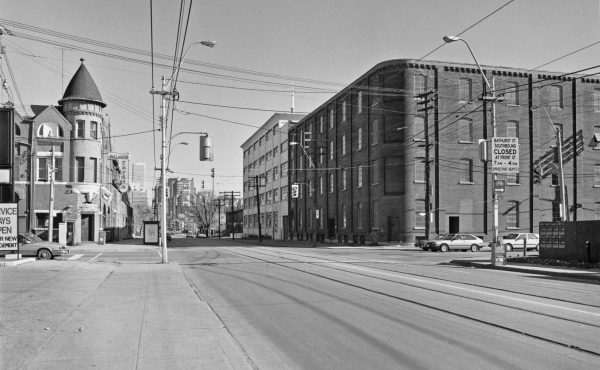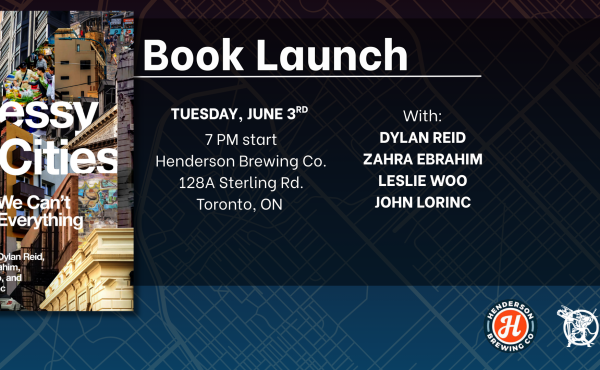

Each week we will be focusing on blogs from around the world dealing specifically with urban environments. We’ll be on the lookout for websites outside the country that approach themes related to urban experiences and issues in Toronto.
– – – – – – – – – – – – – – – – – – – – – – –
• On the Burrard Bridge in Vancouver, one lane of automobile traffic was turned into a divided bike-only lane as part of a six-month trial project. Ten years ago, a similar trial was attempted which lasted only one week due to confrontations between cyclists and drivers. Following a smooth first day, the Vancouver trial hopes to confirm Braess’s Paradox which argues that reducing traffic network capacity can often increase roadway efficiency.
• The Mass Transit Tunnel in New Jersey, a proposed train tunnel under the Hudson River, has officially entered the planning phase. With an $8.7 billion price tag and a timeline of eight years, the projects planners expect to receive more than $3B from President Obama’s economic stimulus package since the tunnel is estimated to create more than 5,600 jobs.
• The remnants of Victory Gardens, small parcels of urban land used to grow food during the two World Wars, provide a good alternative to more intensive forms of urban agricultural schemes. One blogger looks at the victory gardens that have survived and their current manifestations.
• Mock proposals are being put forward by the Manhattan Airport Project to develop an international airport in Central Park. Centrally located, the 843 acre park provides an ideal location for a new massive air hub, which will help reduce congestion and travel times on the highways and traffic arteries to and from New York’s three existing major airports.
• The British Parliament approved four eco-towns to be built in rural England to meet housing needs and attempt to stem climate change. Despite recent controversies and local opposition,the four eco-towns will entail 10,000 environmentally friendly homes and are to be completed by 2016.
• More praise for Seoul’s Cheonggyecheon stream, which replaced the city’s downtown double-decker expressway. The world’s grandest example of daylighting is inspiring other cities around the world to resuscitate their buried creeks and rivers. Maybe it’s time to blow the dust off the Storey+Brown proposal to resurface Toronto’s most famous lost waterway, the Garrison Creek.
• Barak Obama is quickly distinguishing himself from his predecessors by changing federal policy to better address urban issues. The changes include support for public transit, curbing sprawl and improving sustainability.
Photo from Wikimedia




9 comments
How can it be an ‘eco-town’ if it takes land out of production (agricultural or ecological), at a distance from established work and recreation? ‘Que bono?’ I smell development-money contributions to politicians… again.
All the best solutions are low-hanging fruit, but not campaign-worthy, or kick-back producing:
– more transit
– urban in-fill
– congestion charges
– urban forestry
– efficiencies added to existing housing
– etc.
> resurface Toronto’s most famous lost waterway, the Garrison Creek.
That would be great! Even though it is certainly not easy, as it passes through now densely populated areas.
Did April Fool’s Day get moved to July? The Manhattan Airport Project must be some corporate stealth advertising campaign in the works. Too wacky/slick to be real.
Braess’s Paradox is not about net capacity.
re: reducing lanes results in less congestion.
I find it rather telling that the linked article in Christian Science monitor cites “new research” which validates the general thesis that adding more lanes for cars actually results in more congestion.
I’ve seen this articulated and practiced in a variety of historical examples (like from the 1970’s!). Also from the 70’s is the argument (and proof!) that removing on-street parking results in increased business for shops on the street. Yet, these things still seem ‘radical,’ ‘counter-intuitive’ – even ‘paradoxical’!
I’m beginning to think that science and it’s facts don’t really matter.
Manhattan Airport Project is a hoax
http://en.wikipedia.org/wiki/The_Manhattan_Airport_Foundation
I’d say one of the best hoax sites ever.
Re: Garrison Creek
Would love to see it happen; I don’t recall them costing the proposal, but my back-of-hand math would put it somewhere between 400M – 1.3B depending on how much sewer realigning and expropriation were required.
Because of the above, I think getting the whole thing approved at once is probably a non-starter.
But we could unearth the ravines in several places quite easily and moderate cost.
In Trinity Bellwoods park the bridge under Crawford is there. A report a few years ago pegged the cost of unearthing it, restoring it and the ravine at 6M. So probably 7 or 8 now.
In addition, the same phenomenon exists @ Harbord, between Bickford Park and Harbord Park. The bridge is smaller, so I would assume, all other things being equal, 6M or so as a cost.
That would make for a nice start.
The headwaters of the creek, as I understand it, are under Humewood School’s yard, I believe. That’s just north of St. Clair. Unearthing that could be do-able to.
After that it starts to get pricey. (which doesn’t mean we shouldn’t try)
Nice of Vancouver to show some guts and put a lane there on the Burrard Bridge.